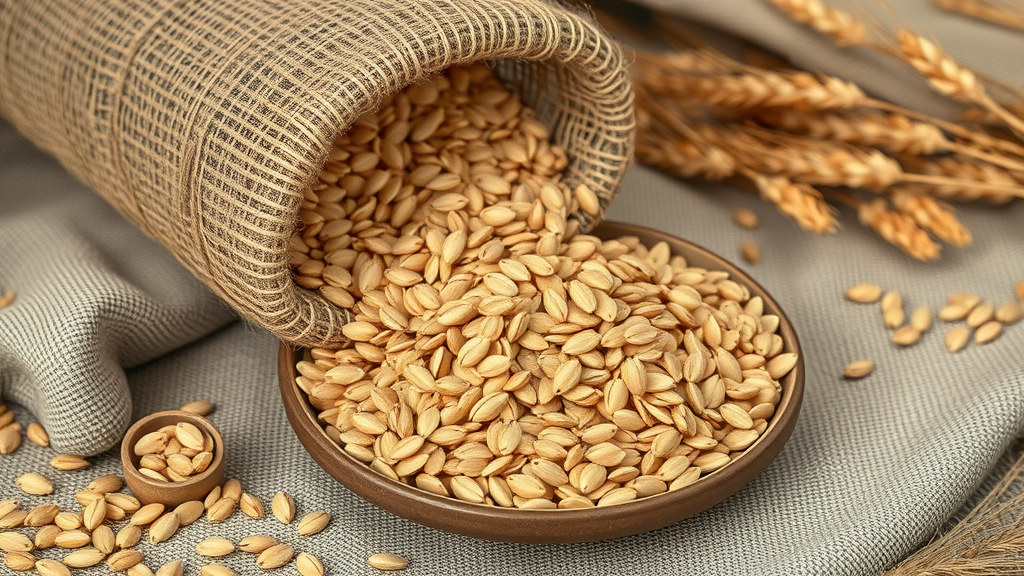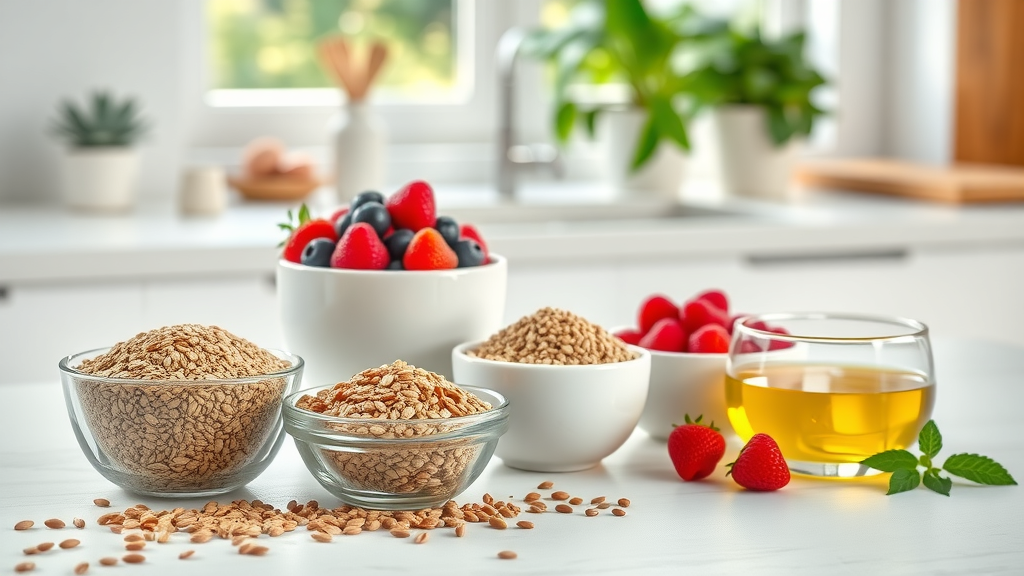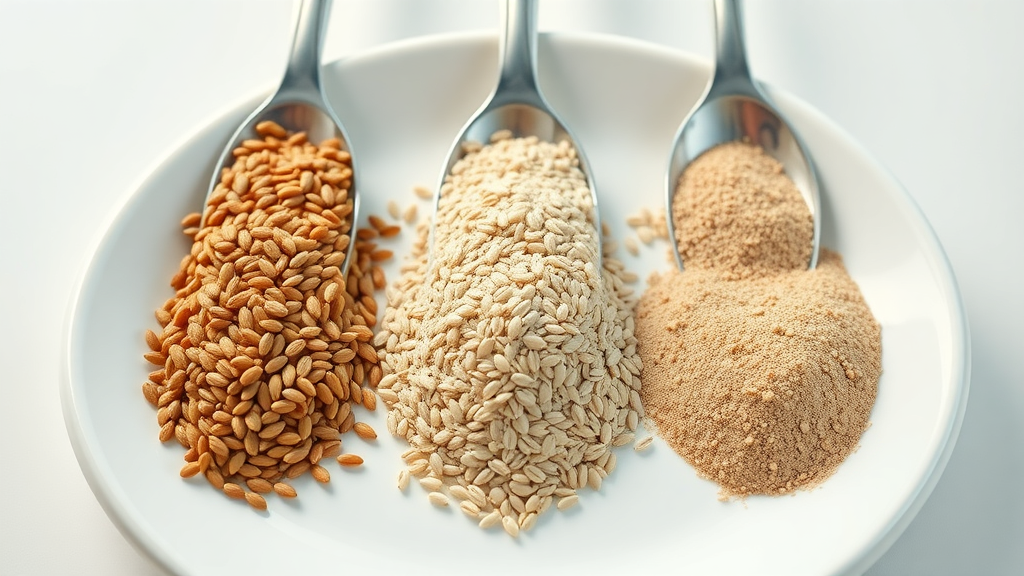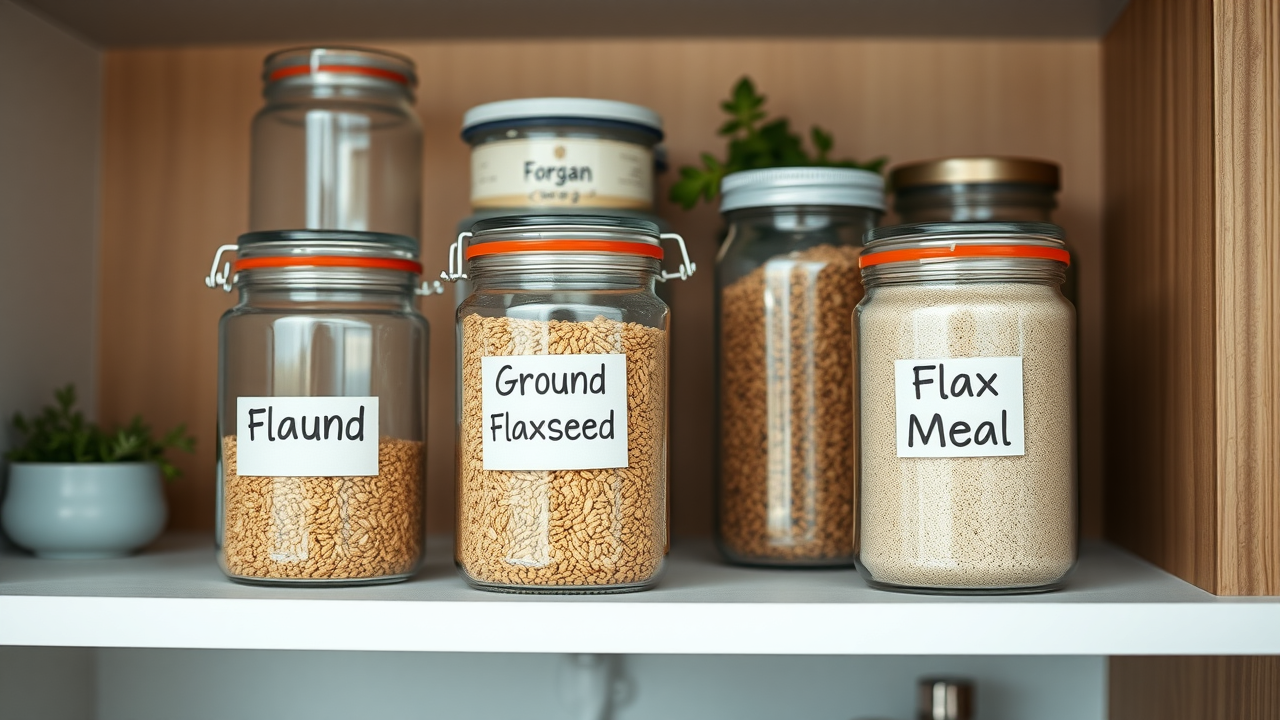Are ground flaxseed and flax meal truly the same, or is there a hidden difference in their seed oils and nutritional benefits that affects your health and recipes? Discover what sets them apart and learn why knowing this can boost your nutrition and enhance your cooking results.

Is Ground Flaxseed the Same as Flax Meal? Introduction to a Common Nutritional Dilemma
“Are ground flaxseed and flax meal interchangeable? Understanding their differences is key to unlocking their nutritional powerhouse potential in every meal.”
Many health-conscious cooks and nutrition seekers ask, is ground flaxseed the same as flax meal or flaxseed meal, and how do their nutritional benefits compare? With these terms often used interchangeably at the grocery store and on recipe blogs, it’s easy to get confused about their distinct nutritional benefits. Yet, the distinction between flax meal and ground flaxseed could be the difference between unlocking the full nutritional benefit or missing out on key health improvements in your diet.
As people become more interested in plant-based eating and flaxseed gains popularity for its heart-healthy fatty acids and digestive benefits, it’s essential to know what form works best for your body and your favorite dishes. This guide delivers a clear, practical comparison—so you can make informed choices that improve both your health and your recipes.

Ground Flaxseed vs. Flax Meal: What’s the Difference?
Defining Ground Flaxseed and Flax Meal in Everyday Nutrition
Flax seeds, also called flaxseed, are small, brown or golden seeds known for their nutty flavor and dense nutritional profile packed with fiber, omega-3 fatty acids, and other health benefits of flax. When these seeds are processed, two popular products result: ground flaxseed and flax meal. Although some brands use the names interchangeably, there are subtle differences in how they are produced and used.
Ground flaxseed, or ground flax, typically refers to whole flax seeds that are finely milled or ground just before packaging to preserve their valuable seed oils and maximize nutritional benefits. This process preserves the oil content, nutrients, and flavor, creating a product rich in healthy fats and dietary fiber. In contrast, flax meal often denotes the ground product left after flaxseed oil has been extracted—making it slightly lower in fat and calories, but still rich in fiber and protein. Understanding this distinction helps you select the right ingredient for higher nutrition and better cooking results.
If you’re interested in how other plant-based foods can support your health and weight management goals, you might also want to explore the nutritional power of beans for fat loss. Beans offer a unique combination of fiber, protein, and micronutrients that complement the benefits of flaxseed in a balanced diet. Learn more about how beans can help unlock your body’s fat-burning potential and discover new ways to diversify your healthy eating routine.
How Are Flax Meal and Ground Flaxseed Made? Differences in Processing
The making of ground flaxseed is a simple mechanical act: whole seeds are crushed using a coffee grinder, mill, or food processor. This process keeps all the components of the seed intact, including precious seed oils, dietary fiber, and micronutrients. Ground flaxseed offers the “whole package”—all the flavor and health benefits that flax seeds are known for.
On the other hand, flax meal is often the byproduct of extracting flaxseed oil. The seeds are cold-pressed to remove a significant portion of the oil, and the leftover press-cake is then milled into a powder (meal). This results in a lower fat and calorie count, but maintains high protein and fiber, making flax meal a popular ingredient in low-fat baking or recipes where oil content needs to be controlled. Choosing between the two depends on your dietary priorities and the specific requirements of your recipes.

Flax Seed Origins: From Whole Flax Seeds to Seed Meal
Flax Seeds: The Source of All Flaxseed Meal and Ground Flax
At the heart of ground flaxseed and flax meal lies the humble flax seed—a tiny, teardrop-shaped powerhouse that comes in brown and golden varieties. Flax seeds are packed with omega-3 fatty acids (ALA), plant-based protein, dietary fiber, and beneficial plant compounds like lignans, which have been studied for their heart-protective benefits. Both brown and golden flax seeds provide similar nutritional values, although the golden variety is sometimes preferred for its lighter color in baked goods.
These seeds are the source material for both ground flaxseed and flax meal, with the main difference being whether the oil has been extracted before milling. When using flax seeds at home, grinding them just before eating ensures you receive all the health benefits they offer, as the hard outer shell makes whole seeds tough for the body to digest. Both ground forms, however, make it much easier to access the flax seed’s nutritional bounty, making them excellent additions to a modern, health-focused diet.

Seed Oils and Nutritional Benefits in Flaxseed and Flax Meal
A key distinction between ground flaxseed and flax meal lies in their seed oils content, which directly impacts their health benefits and best culinary uses. Flaxseed oil, rich in plant-based omega-3 fatty acids, is what sets ground flax apart as a nutritional powerhouse. When flaxseed oil is left intact, ground flaxseed provides more healthy fats—these fats have been linked to reduced inflammation, lower risk of heart disease, and improved skin health. Furthermore, these plant-based oils may support brain health and hormone balance.
In contrast, flax meal, often made from flax seeds after oil extraction, is higher in protein and fiber but lower in fat. It’s still a valuable source of micronutrients, just slightly less potent in omega-3 content compared to ground flaxseed. Both forms, however, provide significant health benefits, supporting digestive regularity, healthy cholesterol levels, and improved satiety in meals. Knowing how the seed oils and nutrients differ helps you choose the right version for your health goals.
Nutritional Powerhouse: Are Flax Meal and Ground Flaxseed Equally Healthy?
Nutritional Benefits of Flaxseed, Flax Meal, and Ground Flax

All three forms—flaxseed, flaxseed meal, and ground flax—offer robust nutritional benefits, but there are important differences. The main nutritional benefits of ground flaxseed arise from retaining the full oil content, keeping heart-healthy fatty acids readily available. This whole-food form also ensures you receive the highest fiber and lignan concentrations, key for digestive health and helping to moderate blood sugar.
Flax meal, often called flaxseed meal, though slightly lower in healthy fats due to seed oils extraction, remains a powerful addition to a nutritional powerhouse diet rich in fiber and protein. It provides more protein per serving, is low in saturated fat, and maintains the plant’s insoluble and soluble fiber. Flax meal is often chosen for low-fat baking or as a protein-boosting supplement in smoothies and cereals. Both options support overall wellness, with studies linking regular flax intake to lower risks of heart disease, blood pressure management, and anti-inflammatory effects.
Key Health Benefits of Flax Meal and Ground Flaxseed
Adding flax meal or ground flaxseed to your diet delivers a cascade of health benefits, thanks to their rich seed oils and fiber content. The high fiber content—both soluble and insoluble—promotes digestive regularity, curbs appetite, and may help lower cholesterol. Flaxseed and flax meal are also unique because of their lignan content, a plant compound known for its antioxidant qualities and possible cancer-protective effects.
Their robust omega-3 fat profile can help reduce inflammation, support heart health, and improve skin texture. Flaxmeal and ground flaxseed can also aid in blood sugar control, making them beneficial for those at risk of or managing diabetes. Some studies suggest they may even help relieve certain menopause symptoms, such as hot flashes, thanks to these plant compounds. However, to maximize these health benefits, it’s crucial to choose the form that aligns with your dietary needs—ground flax for more healthy fats, and flax meal for higher protein and lower calorie snacks.
Comparing Flax Meal vs. Ground Flaxseed vs. Flax Seeds
Form |
Oil/Fat Content |
Protein & Fiber |
Texture |
Best Uses |
|---|---|---|---|---|
Ground Flaxseed |
High (full oils, omega-3 fatty acids) |
High |
Fine, slightly oily, nutty flavor |
Smoothies, baking, cereal, yogurt, salads |
Flax Meal |
Lower (oil extracted) |
Higher protein, very high fiber |
Drier, flour-like, milder nutty flavor |
Baking (breads, pancakes), protein shakes, low-fat recipes |
Whole Flax Seeds |
High (locked in seed) |
High, but less accessible |
Crunchy, hard shell, nutty flavor |
Toppings, granola, but needs grinding for full benefits |

How to Use Flax Meal and Ground Flaxseed in Your Recipes
Practical Tips for Cooking and Baking with Flaxseed and Flaxseed Meal
Both ground flaxseed and flax meal are remarkably versatile ingredients for home cooks seeking to upgrade their nutrition and incorporate the benefits of flaxseed and flaxseed meal into everyday recipes. Ground flax integrates seamlessly into smoothies, oatmeal, yogurt, or homemade energy bars, providing a mild, nutty flavor and healthy fats that enrich both savory and sweet dishes. Flax meal, being drier and less oily, is ideal for baking—adding moisture and structure to muffins, pancakes, or gluten-free breads. For egg-free baking, mix 1 tablespoon of either meal with 2.5 tablespoons of water and allow it to gel for a natural, plant-based egg substitute.
To maximize nutritional benefit, consider grinding whole flax seeds just before use, as pre-ground versions may lose some seed oils and nutrients if stored improperly. Always keep both products in airtight containers in the fridge or freezer to maintain freshness. When adapting recipes, remember that ground flaxseed may create a denser texture, while flax meal offers a lighter crumb. Adjust liquids as needed if swapping one for the other, and experiment to find your perfect taste and health balance.
Watch: Step-by-Step Guide to Grinding Flax Seed and Making Flax Meal at Home
Are There Any Risks or Downsides? Flax Meal, Ground Flaxseed, and Health Considerations
Who Should Limit Flaxseed or Seed Meal Intake?
While most people benefit from adding flax meal or ground flaxseed to their diets, certain populations should proceed with caution due to the potent seed oils and fiber content. Flaxseed contains high levels of fiber and phytoestrogens, which may interact with specific medications or exacerbate gastrointestinal issues. For individuals with inflammatory bowel disease or those prone to digestive discomfort, it’s wise to start with small amounts and monitor tolerance.
People taking blood thinners or medications for heart disease, high blood pressure, or hormonal therapies should speak with their healthcare provider before regular flax consumption, as flax’s unique plant compounds may enhance or reduce the efficacy of some prescriptions. Moderation is key, and most adults can safely consume 1–2 tablespoons daily as part of a balanced diet.

Interactions with Medications and Special Diets (e.g., Dialysis, Pregnancy)
Special populations—including those on dialysis, pregnant individuals, or those with hormone-sensitive conditions—are advised to consult a dietitian or healthcare professional before incorporating significant amounts of flaxseed and flax products. Flax’s potent omega-3s and plant lignans, while generally beneficial, may interfere with certain medications or affect delicate health balances. For instance, excessive intake may alter potassium levels in dialysis patients or impact hormone levels in pregnancy.
Always disclose your supplement and dietary habits to your medical team, especially if you’re managing chronic conditions or taking medication for blood pressure, diabetes, or hormonal regulation. A personalized approach ensures you gain the most benefit of flax while staying safe.
People Also Ask: Ground Flaxseed vs. Flax Meal
Can you substitute flaxseed for flaxseed meal?
Answer: Explore the texture, nutritional, and recipe impacts of swapping flaxseed with flaxseed meal.
You can often substitute ground flaxseed for flax meal in recipes, but expect changes in both texture and nutrition. Whole flaxseed won’t provide the same benefits, as its tough hull resists digestion, making the nutrients inaccessible. Ground flaxseed offers more omega-3 oils, while flax meal is ideal for low-fat or high-protein baking. When substituting, expect a denser, more moist result with ground flax, and lighter, drier texture with flax meal. Adjust liquids if swapping and, for full nutritional benefit, avoid using whole, unground seeds as a 1:1 substitute for meal.

Which is better, flaxseed meal or ground flaxseed?
Answer: Examine differences in nutrition, absorption, and best uses for each form.
The best choice depends on your dietary goals. Ground flaxseed has the edge nutritionally due to its intact omega-3 oils, delivering more healthy fats and plant-based nutrients. It’s optimal for supporting heart health, inflammation reduction, and skin benefits. Flaxseed meal, with its increased protein and fiber and reduced fat, shines in weight-conscious recipes or those needing a mild-flavored, drier meal to improve baked goods’ structure. For maximum absorption and benefit, always choose ground flax or meal over whole flax seed, but let your recipe and nutrition priorities guide your selection.
Is flaxseed good for dialysis patients?
Answer: Delve into the latest research on flaxseed consumption for kidney health.
Current research suggests small amounts of ground flaxseed can provide fiber and plant protein to support health in those with chronic kidney disease, but caution is needed. Flaxseed is high in phosphorus and potassium, minerals dialyzed patients may need to limit. Always consult with your renal dietitian before adding flaxseed meal or ground flax to your diet, as individual needs vary based on lab results and current kidney function. Used carefully, flaxseed can be included, but portion control and professional guidance are essential for kidney health.

Is flaxseed safe during pregnancy?
Answer: Discuss potential risks and expert recommendations regarding flaxseed intake while pregnant.
Flaxseed and flaxseed meal can be included during pregnancy for their protein, fiber, and omega-3 fatty acids content, but moderation is key to safely enjoy the benefits of flax. Concerns stem from flax's phytoestrogens, which could potentially influence hormone levels. Most experts recommend limiting daily intake to 1–2 tablespoons of ground flaxseed or meal, and always consulting your OB-GYN or dietitian for guidance based on your personal health profile. While there’s no evidence flax causes harm when consumed in reasonable amounts, always err on the side of caution and avoid supplements or excessive intake while pregnant.
FAQs: Is Ground Flaxseed the Same as Flax Meal and Beyond
Do flaxseed, flaxseed meal, and ground flaxseed taste the same?
All three forms—whole flax seeds, ground flaxseed, and flax meal—retain a gentle nutty flavor, but ground flaxseed tends to be richer and mildly oily due to its seed oils, while flax meal is drier and milder. Whole flaxseeds provide a crunchy bite but little flavor unless chewed thoroughly or ground. For most recipes, the taste difference is subtle, and both meal and ground forms blend well without overpowering dishes.
How should flax meal or ground flaxseed be stored?

Due to their sensitive seed oils, both flax meal and ground flaxseed should be stored in airtight containers in the refrigerator or freezer to preserve their nutritional benefits. This prevents the natural oils from turning rancid and preserves the nutritional benefits. Keep containers away from heat and sunlight, and always check for off smells before use. Proper storage helps you enjoy the best flavor and health benefits with every serving.
Are there advantages to using whole flax seeds over flax meal or ground flaxseed?
While whole flax seeds have a longer shelf life thanks to their intact hull, their nutrients are poorly absorbed unless ground, making ground flax and flax meal better choices for health benefits. Eating them whole usually results in the seeds passing through your digestive system undigested, limiting access to omega-3s, fiber, and plant nutrients. Ground flaxseed and flax meal are much better choices for maximizing health benefits. If you want the best of both worlds, buy whole seeds and grind them just before eating.
Conclusion: Understanding If Ground Flaxseed Is the Same as Flax Meal for Healthier Choices
Understanding the subtle but important differences between ground flaxseed, flaxseed meal, and flax meal empowers you to choose the best form for your health and recipes—ensuring you maximize nutritional benefits, seed oils retention, enjoy better flavors and textures, and meet your wellness goals with confidence.
If you’re inspired to take your nutrition journey even further, consider exploring how your food choices can support not just your digestive health, but also your body’s natural detoxification processes. Discovering the top foods to detox your kidneys naturally can provide a holistic boost to your wellness routine, helping you feel more energized and resilient. Uncover the best foods for kidney health and learn how simple dietary upgrades can make a lasting impact on your vitality. Your next step toward optimal health could be just one ingredient away.
Sources
When exploring the differences between ground flaxseed and flaxseed meal, it’s essential to understand their production processes and nutritional content. Ground flaxseed is made by finely grinding whole flaxseeds, preserving all their natural oils, omega-3 fatty acids, fiber, and lignans. This form ensures maximum nutrient absorption, as the grinding process breaks down the hard outer shell, making the nutrients more accessible. (livestrong.com)
In contrast, flaxseed meal often refers to the byproduct left after extracting flaxseed oil. This process removes a significant portion of the oil content, resulting in a product lower in fat and omega-3s but still rich in fiber and protein. While both forms offer health benefits, ground flaxseed provides a more comprehensive nutrient profile due to the retention of its natural oils. (manitobaflax.com)
Therefore, while the terms are sometimes used interchangeably, ground flaxseed and flaxseed meal differ in their nutritional content and processing methods. For optimal health benefits, especially regarding omega-3 intake, ground flaxseed is the preferred choice.
 Add Row
Add Row  Add
Add 




Write A Comment